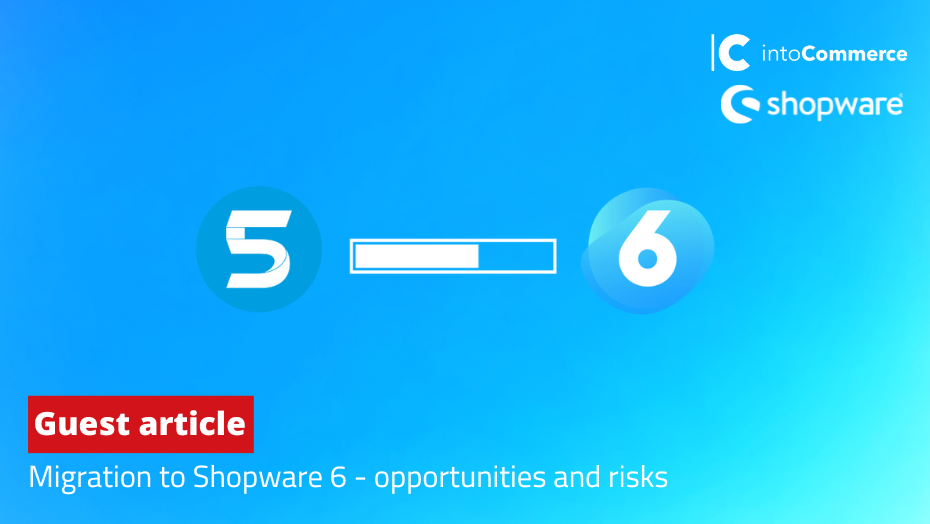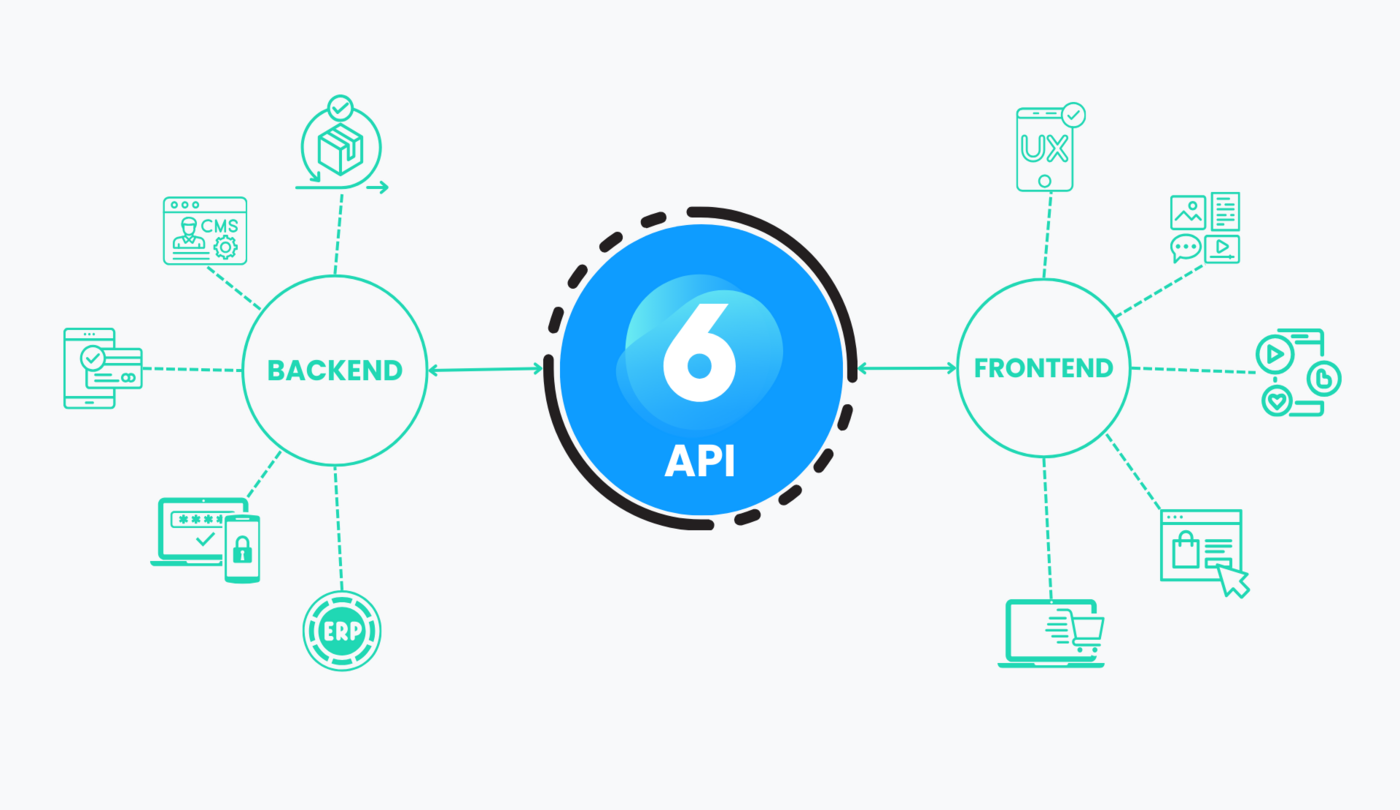
Now, however, Shopware will only provide security updates and full support will be discontinued in July 2024. What to do now and what to consider when migrating to Shopware 6 can be found in this blog post from our partner intoCommerce.
Why you should switch to Shopware 6
What happens without a Shopware update?
The decision not to migrate from Shopware 5 to Shopware 6 carries several potential risks and drawbacks. First of all, the security risks increase significantly as the manufacturer stops supporting Shopware 5, including providing security updates. This makes your online shop more susceptible to security vulnerabilities and attacks, which brings with it the risk of data loss or impairment of shop functionality.
Furthermore, Shopware 5 is based on outdated technologies and architectures, which can lead to performance problems, especially with growing traffic and product catalogue.
New features and integrations can also be difficult to add. An outdated shop can also affect the customer experience, as slow load times, lack of mobile customisation and an outdated user interface can cause customers to leave, resulting in lost sales.
Using Shopware 5 could also limit access to current extensions and plugins, as developers now primarily develop for Shopware 6. Compatibility issues with other software components or services may also occur, jeopardising the smooth functioning of the online shop.
Finally, there is the risk of a competitive disadvantage if competitors switch to Shopware 6 and benefit from the advantages while your shop is not up to date and does not offer the same functions and performance. Therefore, switching to Shopware 6 is often a strategically smart decision to stay competitive and secure.
See the migration to Shopware 6 as an opportunity
More and satisfied customers
With Shopware 6, you have more opportunities to support your customers digitally. With the new features of Shopware 6, your online shop can be integrated into the customer journey more easily and efficiently. Your customers are given a new user-friendly shopping experience that is always intuitive and responsive. In addition, Shopware 6 can be personalised to meet the individual wishes of customers.
New features for B2B shops
Shopware 6 is a powerful system that can address many typical B2B e-commerce challenges with Rule Builder, Intelligent Search and a new B2B Suite. The automation and improvement of increasingly complex B2B business processes are the focus of Shopware 6, so it offers a wide range of features specifically designed for B2B e-commerce to meet the needs of companies and business customers.
New functions and possibilities with Shopware 6

What are the main benefits of Shopware 6 migration?
- Improved performance: Shopware 6 has been redesigned from the ground up to offer optimised performance. This means faster load times, improved scalability and a smoother user experience, which can lead to higher conversion rates.
- Modern design and user experience: Shopware 6 offers a modern and responsive design that enhances usability and creates an engaging shopping experience for your customers.
- Advanced features and integrations: These include, for example, powerful marketing tools, improved SEO functions and the seamless integration of third-party apps and services.
- Longer support and security updates: The migration gives you longer support and regular security updates, which ensures the security of your shop and minimises the risk of security holes and attacks.
- Active community and extensions: A great added value is also provided by an active developer community that continuously develops new extensions and plugins. This allows you to add new features to your shop and keep it up to date.
- Better scalability: Shopware 6 is better equipped for the growth of your online business. It can easily handle increasing traffic and a growing product catalogue.
However, it is important to note that the migration from Shopware 5 to Shopware 6 should be carefully planned and implemented to minimise any potential disruption. Professional support can often be helpful to ensure that the migration goes smoothly and that all benefits can be reaped.
Shopware 6 new functions

Headless and API-First approach
Shopware 6 follows the "API-First" approach. By splitting the frontend and backend, this system can act independently, which is called "headless".
This means that the technological basis, including the databases, functions separately from the user interface. In this way, it is possible to store data independently and make it available via interfaces in suitable formats for different application areas.
This method enables a flexible connection to diverse sales channels without having to adapt the data separately for each channel. The "API-First" approach thus forms a solid basis for opening up new sales channels with minimal effort.
Multiple sales channels
Shopware 6 supports the management of multiple sales channels via a central platform. This enables the management of B2B and B2C shops as well as the connection to various marketplaces.
In the context of Shopware 6's functions, it is possible to manage all content centrally and to offer products specifically according to their main target group in the respective sales channels.
The worlds of experience
The experience worlds of Shopware 6 aim to seamlessly combine content and commerce. The intuitive use and customisation of this feature is facilitated by predefined elements, such as home or promotion pages. These elements can be further adapted and individualised according to your ideas. The individualisation of the content does not require any special knowledge in design or programming. This simplifies the work in interaction with a content management system (CMS) enormously.
Further functions
Improved SEO tools: Shopware 6 offers enhanced SEO functions and tools to increase the visibility of your online shop in search engines. This includes, among other things, the simple adjustment of meta tags, URLs and sitemaps.
- Advanced marketing tools: Shopware 6 offers powerful marketing tools to promote customer loyalty and increase sales. These include personalised recommendations, cross-selling and upselling features.
- New Administration Panel: Shopware 6's backend has been redesigned to provide a user-friendly interface with improved usability for shop administrators.
- Improved product data management: The management of product data has been optimised in Shopware 6, making it easier to maintain and update large product catalogues.
Shopware 6 for B2B
The latest version of Shopware 6 brings exciting and innovative features to B2B e-commerce. With a clear focus on the needs of businesses, Shopware 6 now offers an even more comprehensive range of tools and features to help B2B merchants sell successfully online. From customised pricing structures and flexible discounting systems to powerful order processing features and seamless integration with existing ERP systems, Shopware 6 takes the B2B experience to a new level. In the following part, we take a closer look at some of the exciting new features Shopware 6 has in store for B2B merchants.
Product variants
The management of product variants in Shopware 6 is significantly simplified compared to Shopware 5. A product is mainly defined by its various characteristics.
These product specifications can be assigned not only to the actual product, but also to its various variants. This allows you, for example, to maintain and manage product properties such as weight and size in one central location.
The Rule Builder

The Rule Builder in Shopware 6 allows you to create specific rules and dependencies within your online shop. With this tool, you can define specific sets of rules, for example, to display individualised content, prices or shipping costs in the online shop. With the help of the Rule Builder, you can also create rules for customers, products and sales channels. By linking different criteria using the "And" and "Or" operators, even demanding requirements can be implemented easily without the need for additional programming.
Shopware 6 B2B Suite
- Staff roles and permissions: Define your staff's access rights: sales staff can manage B2B customer accounts, place orders on behalf of customers and provide personal advice via digital sales rooms. Centralised company structure: Manage your company structure transparently with clear roles such as sales manager, regional manager and sales representative. Assign them individual permissions and restrictions.
- Customised pricing: Stand out from the crowd by offering flexible pricing strategies based on product range, order frequency and order size.
- Efficient large order processing: Simplify reordering and large order volumes with innovative ordering processes and employee approval mechanisms.
- Quotation management: Enable smooth quotation management, from quotation creation to acceptance or rejection of customer quotations.
- Easymode for customers: Activate Easymode for selected customers to reduce the complexity of account settings while maintaining basic B2B functions.
- Customer statistics: Capture and filter relevant customer data, including order history and financial information, with built-in statistics capabilities in the B2B suite.
- API Integration: Seamlessly integrate existing workflows into B2B Suite and connect it to your established system infrastructure such as ERP and CRM thanks to Shopware's API-first approach. Innovative Features: Delight your customers with an outstanding user experience and combine the B2B suite with advanced features like Shopware's Digital Sales Rooms and Advanced Search.
Shopware 5 to Shopware 6 in practice
During a migration, the existing information from Shopware 5 is completely rewritten into a new product. Shopware 6 was developed from scratch and therefore has profound changes. This means that in addition to transferring the data from Shopware 5, further configurations, functions and extensions have to be implemented. Migration is therefore a complex procedure that integrates the existing project into a completely new environment.
Before this can be implemented, the initial situation should be determined. Concrete and effective measures can then be planned for the successful migration process.
To begin with, the new Shopware 6 shop is created with all the required plug-ins in such a way that the new Shopware functions can be used optimally. Then, if necessary, Shopware 6 and your ERP should be connected for a smooth data exchange and checked several times.
As the project progresses, further optimisations should then be made along the lines of the company's goals and customer reactions to ensure the best possible buying experience for customers.
About intoCommerce

intoCommerce is the number 1 Shopware Gold Partner in Germany and one of the top 10 Shopware partner agencies. With almost 10 years of experience and over 200 successfully implemented e-commerce projects, they are specialists in B2B e-commerce. From consulting to development to permanent support of the online shop, intoCommerce helps companies to achieve sales via the internet as quickly and sustainably as possible.




